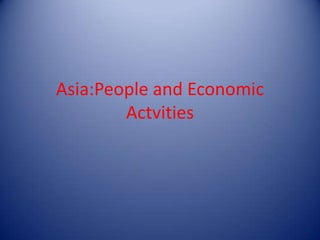Les.11 asia
- 1. Asia:People and Economic Actvities
- 2. Occupations âĒ About three-fourth of the population in Asia depend on agriculture for their livelihood. âĒ Farming â China-Because of good soil and climate âĒ Nomadic herders- South-West Asia and Central Asia âĒ Lumbering-Coniferous belt in Siberia âĒ Fishing âCoastal regions around Japan âĒ Mining & Manufacturing- Japan, China, India and Asiatic Russia.
- 3. Agriculture âĒ The most common type of agriculture is the intensive subsistence agriculture. âĒ Small plots âĒ Manures and irrigation is practised for yield. âĒ Rotation of crops to maintain fertility of soil. âĒ Lot of manual labour âĒ Involvement of family members and very less surplus crops are grown. âĒ Found in China, India, Southeast Asia
- 4. Extensive Commercial Agriculture âĒ Large farms âĒ Use of machines for ploughing and harvesting âĒ Small number of labour. âĒ Crops meant for sale. âĒ Practised in steppe grasslands of Siberia and irrigated lands of central Asia.
- 5. Plantation Agriculture âĒ Large area planted with same crop âĒ Work is organised as in industry. âĒ They have factories to process the product for sale. âĒ Eg. Tea, Coffee, Rubber are grown in plantations. âĒ These crops continue to yield for 30-40 years or more.
- 6. Shifting Agriculture âĒ Practised by the tribal people of India, Malaysia and Indonesia. âĒ Forest are cleared by setting fire to the trees and clearings are used for growing mainly root crops. âĒ The land regains its fertility after 2 to 3 years. âĒ The tribal people again migrate to these land.
- 7. Chief Crops âĒ Rice- India, China, Indonesia and Countries of Southeast Asia. âĒ Wheat- Tropical regions such as north India, parts of China, Russia, North China and South- west Asia. âĒ Millets, pulses and oil seeds- rain-fed crops âĒ Tropical crops- Sugarcane and Tea plant âĒ Non-food crops- Cotton, Jute, Silk
- 8. Oilseeds Millets Rice Wheat Pulses
- 9. Industries âĒ Manufacturing industries have been developed in Japan, Russia, China and India. âĒ Japan produces wide range range of manufactured goods from iron and steel to electronic goods and computers. âĒ Asiatic part of Russia has a few industries in western Siberia, China has diversified industries based on agricultural and mineral raw materials. âĒ Rapid growth shown in China in last 20 years.
- 10. âĒ India has established number of modern industries like steel plants, Chemical industries, textiles, fertilisers, cement, thermal power, atomic power, heavy engineering, electrical and electronic industries. âĒ Industries not developed in South-west and South-east Asia. âĒ Singapore has grown as large business, industrial and tourism centre.
- 11. Population âĒ Asia has about 60 per cent of the worldâs population, making it the most populous continent. âĒ Concentration of people in eastern and southern parts of Asia. âĒ Most populous countries of the world are also located here.










